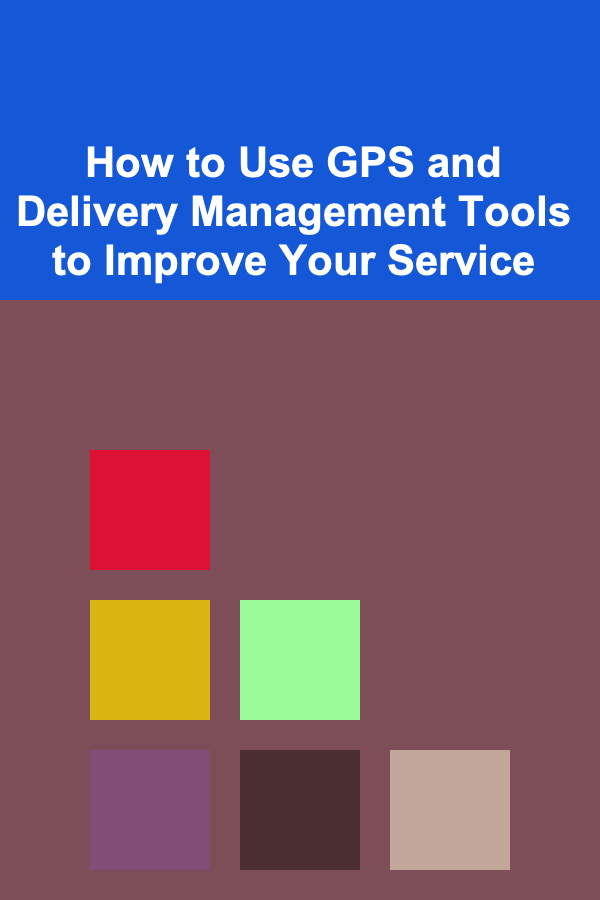
How to Use GPS and Delivery Management Tools to Improve Your Service
ebook include PDF & Audio bundle (Micro Guide)
$12.99$8.99
Limited Time Offer! Order within the next:

In the fast-paced world of logistics and delivery services, the competition is fierce, and customer expectations are high. One of the most critical aspects of customer satisfaction in this industry is timely and accurate deliveries. To stay ahead, businesses must leverage technology to streamline operations, optimize delivery routes, and improve overall efficiency. Among the most powerful tools for achieving this are GPS (Global Positioning System) and delivery management tools.
This actionable guide will delve into how you can effectively use GPS and delivery management tools to enhance your service, reduce costs, and increase customer satisfaction. Whether you're running a local delivery service, managing a fleet of vehicles, or overseeing complex supply chains, these tools can provide real-time insights and streamline your processes.
Understanding GPS and Delivery Management Tools
Before we dive into the specific strategies, let's define the key tools you'll be working with.
GPS Tools
GPS technology provides real-time location tracking, enabling businesses to monitor the precise location of delivery vehicles or packages. The data collected from GPS can be used to:
- Track delivery progress in real-time
- Estimate delivery times more accurately
- Provide insights into the driver's route, speed, and behavior
Delivery Management Tools
Delivery management tools are software platforms that help businesses coordinate the logistics of deliveries. These tools often integrate with GPS tracking systems and provide features like:
- Route optimization: Automating the process of finding the best delivery routes
- Scheduling: Managing delivery windows and driver assignments
- Real-time updates: Communicating with customers regarding their delivery status
- Performance analytics: Tracking delivery times, customer feedback, and driver efficiency
When combined, GPS and delivery management tools provide an integrated solution that can drastically improve your delivery operations.
Optimize Delivery Routes Using GPS and Route Planning Software
One of the primary benefits of GPS technology in the delivery process is its ability to optimize routes. Delivery management tools that incorporate GPS data can automatically calculate the most efficient routes based on real-time traffic conditions, weather, and road closures.
How to Use GPS for Route Optimization
- Real-Time Traffic Data: GPS tools can integrate with traffic data to adjust routes dynamically based on road conditions. If there's an accident or traffic jam on a certain route, the system can reroute drivers instantly to avoid delays.
- Time and Distance Analysis: Delivery management tools can compare multiple routes and select the one that minimizes both time and distance. This helps in reducing fuel costs and speeding up deliveries, which leads to increased efficiency.
- Delivery Prioritization: Some delivery management tools allow you to categorize deliveries by priority or customer location, ensuring that high-priority or time-sensitive deliveries are handled first.
- Fleet Monitoring: GPS allows you to monitor your fleet in real-time. By analyzing historical data from past deliveries, you can continuously refine and optimize your routing strategies.
Practical Tip
Incorporate predictive analytics into your GPS and route planning tools. By analyzing historical traffic patterns and seasonal trends, your system can better predict potential delays, improving the accuracy of delivery time estimates and route optimization.
Enhance Customer Communication with Real-Time GPS Tracking
Customer satisfaction is a crucial element in delivery services. One of the main complaints customers often have is the lack of visibility into the status of their deliveries. With GPS tracking, you can offer transparency and real-time updates, which helps build trust and improve the customer experience.
How to Use GPS for Customer Updates
- Real-Time Tracking Links: Provide customers with a link that allows them to track their delivery in real-time. This way, customers can see where their package is and when to expect it. Such visibility reduces anxiety and provides clarity about the timing of deliveries.
- Estimated Time of Arrival (ETA): GPS tools can provide accurate ETAs based on current traffic conditions, driver speed, and distance to the destination. Communicating these ETAs to customers allows them to plan better and minimizes missed deliveries.
- Automated Notifications: Integrate GPS tracking with your delivery management system to send automated notifications to customers about their order status. These can include updates on when the delivery is en route, when the driver is nearby, or if there are any unexpected delays.
Practical Tip
Use a multi-channel approach for customer notifications. Send updates through multiple platforms (SMS, email, mobile app) to ensure that your customers receive timely and accurate information in the format they prefer.
Improve Delivery Efficiency with Dynamic Scheduling and Dispatching
Delivery management tools that integrate with GPS can help businesses make more informed decisions about scheduling and dispatching. Instead of manually assigning deliveries or relying on outdated data, these tools can dynamically adjust to real-time conditions.
How to Use GPS for Dynamic Scheduling
- Automated Scheduling: Delivery management software can automatically assign orders to the best available drivers based on their location and proximity to the delivery address. This helps optimize your fleet's capacity and reduces idle time.
- Load Balancing: Use GPS data to monitor the capacity of each vehicle. When a driver is already handling several deliveries in a particular area, the system can prioritize assigning them additional orders that are geographically closer, thus reducing unnecessary travel.
- Flexible Reassignments: GPS tracking allows you to make quick adjustments if there are delays, such as traffic congestion or a driver's unavailability. Orders can be reassigned to the next closest driver without significantly impacting delivery times.
Practical Tip
Integrate GPS with your customer service team's communication platform. If a driver is delayed or facing an issue, the customer service team can proactively inform customers and update the delivery schedule accordingly, reducing frustration and improving service reliability.
Reduce Costs with Fuel and Time Management
Fuel consumption and driver time are two of the most significant expenses in the delivery business. GPS and delivery management tools can help minimize these costs by providing insights into driving behavior, route efficiency, and overall fleet performance.
How to Use GPS for Cost Reduction
- Fuel-Efficient Routing: Route optimization based on GPS data ensures that your drivers take the shortest or most efficient routes, which helps in reducing fuel consumption.
- Driver Behavior Monitoring: GPS tools can track driving behavior such as speed, harsh braking, and rapid acceleration. By identifying inefficient driving patterns, you can provide feedback and training to drivers, helping them reduce fuel consumption and improve driving habits.
- Idle Time Reduction: GPS can also detect when a vehicle is idling unnecessarily. By reducing idle time, you save fuel and improve delivery efficiency.
Practical Tip
Consider implementing a rewards system for drivers based on fuel efficiency and adherence to optimized routes. This will motivate drivers to adopt more sustainable driving habits, reducing costs and improving overall performance.
Leverage Data for Continuous Improvement
The data collected from GPS and delivery management tools can be a goldmine for continuous improvement. By analyzing key metrics, businesses can identify bottlenecks, monitor driver performance, and make data-driven decisions to enhance their service.
How to Use GPS Data for Analytics
- Performance Metrics: Track delivery times, driver behavior, and route efficiency to identify patterns. Use this data to set benchmarks and improve operational performance.
- Customer Satisfaction Insights: Analyze delivery times and compare them to customer feedback. If customers are consistently unhappy with delivery times, it may indicate the need for better route optimization or scheduling practices.
- Predictive Maintenance: GPS data, combined with vehicle diagnostics, can help predict when a vehicle might require maintenance. This proactive approach helps avoid costly breakdowns and keeps your fleet running smoothly.
Practical Tip
Regularly review and analyze data to identify areas for improvement. Set up automated reporting in your delivery management system to track KPIs (key performance indicators) such as on-time delivery rate, average delivery time, and fuel efficiency.
Conclusion
Integrating GPS and delivery management tools into your operations can significantly enhance your service by improving efficiency, reducing costs, and increasing customer satisfaction. From optimizing routes and improving communication with customers to providing real-time insights into fleet performance, these tools offer numerous benefits for businesses aiming to stay competitive in the logistics space.
By leveraging these technologies and continually refining your strategies based on real-time data and analytics, you can ensure that your delivery service remains efficient, reliable, and customer-focused, ultimately driving long-term success.

How to Mix High and Low for a Chic Home Design on a Budget
Read More
How To Pair Craft Beer with Food
Read More
How to Start a Painting or Photography Service for Clients: An Actionable Guide
Read More
Making Money with Deep Learning: The Best Passive Income Strategies
Read More
How to Understand the Biology of Squids and Cuttlefish
Read More
Mastering the Art of Quick & Healthy Sheet Pan Meals
Read MoreOther Products

How to Mix High and Low for a Chic Home Design on a Budget
Read More
How To Pair Craft Beer with Food
Read More
How to Start a Painting or Photography Service for Clients: An Actionable Guide
Read More
Making Money with Deep Learning: The Best Passive Income Strategies
Read More
How to Understand the Biology of Squids and Cuttlefish
Read More